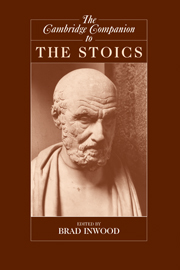Book contents
- Frontmatter
- Introduction
- 1 The School, from Zeno to Arius Didymus
- 2 The School in the Roman Imperial Period
- 3 Stoic Epistemology
- 4 Logic
- 5 Stoic Natural Philosophy (Physics and Cosmology)
- 6 Stoic Theology
- 7 Stoic Determinism
- 8 Stoic Metaphysics
- 9 Stoic Ethics
- 10 Stoic Moral Psychology
- 11 Stoicism and Medicine
- 12 The Stoic Contribution to Traditional Grammar
- 13 The Stoics and the Astronomical Sciences
- 14 Stoic Naturalism and Its Critics
- 15 Stoicism in the Philosophical Tradition
- Bibliography
- List of Primary Works
- Index
5 - Stoic Natural Philosophy (Physics and Cosmology)
Published online by Cambridge University Press: 28 May 2006
- Frontmatter
- Introduction
- 1 The School, from Zeno to Arius Didymus
- 2 The School in the Roman Imperial Period
- 3 Stoic Epistemology
- 4 Logic
- 5 Stoic Natural Philosophy (Physics and Cosmology)
- 6 Stoic Theology
- 7 Stoic Determinism
- 8 Stoic Metaphysics
- 9 Stoic Ethics
- 10 Stoic Moral Psychology
- 11 Stoicism and Medicine
- 12 The Stoic Contribution to Traditional Grammar
- 13 The Stoics and the Astronomical Sciences
- 14 Stoic Naturalism and Its Critics
- 15 Stoicism in the Philosophical Tradition
- Bibliography
- List of Primary Works
- Index
Summary
INTRODUCTION
According to Diogenes Laertius, most of the Stoics - beginning with Zeno of Citium - divided philosophical doctrine into three parts: one physical, one ethical, and one logical. Diogenes also reports three homely similes concerning the relation among these parts of philosophy: (1) philosophy is like an animal, with logic corresponding to the bones and sinews, ethics to the more fleshy parts, and physics to the soul; (2) philosophy is like an egg, with logic corresponding to 'the outside' (shell), ethics to 'what is in between' (the white), and physics to 'the innermost part' (yolk); and (3) philosophy is like a productive field, with logic corresponding to the enclosing fence, ethics to the crop, and physics to the earth or trees.
Whatever the precise import of these similes might have been, it seems clear that the Stoics held that physical doctrine stands in an intimate relation to ethics. For the Stoics, the end of human life is ‘to live conformably with nature’ (to homologoumenon têi phusei zên). Consequently, physics – that part of philosophy that pertains to nature and that reveals the import of living ‘conformably with nature’ – obviously has ethical import. Logically distinct from this aspect of the relation of physical doctrine to ethics is a second point of connection between the two: the common contemporary assumption that it is both possible and desirable to undertake a ‘valueneutral’ investigation of nature is quite foreign to Stoic thought. Indeed, it is common to find what might be termed large-scale Stoic philosophical themes influencing physical doctrine – including some of the rather technical aspects of Stoic physical doctrine. In particular, the Stoic themes of the unity and cohesion of the cosmos and of an all-encompassing divine reason controlling the cosmos are of fundamental importance to Stoic physics.
- Type
- Chapter
- Information
- The Cambridge Companion to the Stoics , pp. 124 - 152Publisher: Cambridge University PressPrint publication year: 2003
- 22
- Cited by



